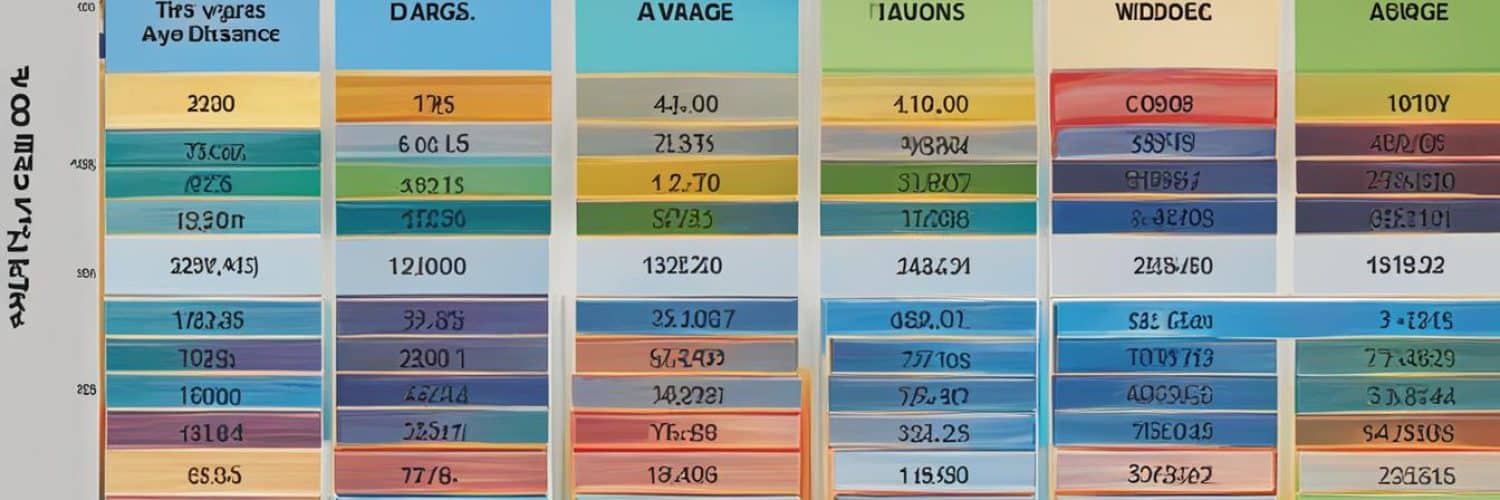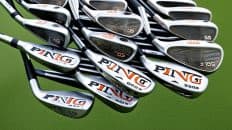Determining the average distance for each golf club is an essential aspect of the game. Whether you’re a beginner or a seasoned player, understanding the distances can help you make more informed decisions on the course. In this comprehensive guide, we will explore the average distances for golf clubs for both amateur and professional players, factors that influence these distances, and tips to improve your overall distance.
Key Takeaways:
- Knowing the average distance for each golf club is crucial for making informed decisions on the course.
- Factors such as loft angle, shaft weight and flex, swing speed, clubhead size, age and health, weather conditions, and the type of golf ball you use can influence your club distances.
- Male golfers have their own average distances, while female golfers have differing averages.
- PGA Tour players and LPGA Tour players hit their clubs at different distances.
- Tracking your club distances can help you assess your performance and make improvements to your game.
Average Golf Club Distances for Male Golfers
When it comes to average golf club distances for male golfers, it’s important to understand that these numbers are not set in stone. They can vary depending on individual factors such as swing speed and skill level. However, based on research and various studies, we can provide you with a general breakdown of the average distances for each golf club.
Before we dive into the numbers, it’s crucial to note that these averages are just guidelines. Your own performance on the course may differ, and that’s completely normal. Use these numbers as benchmarks to track your progress and make adjustments to your game.
So without further ado, here’s a breakdown of the average distances for male golfers:
| Club | Average Distance |
|---|---|
| Driver | 250-275 yards |
| 3-Wood | 220-240 yards |
| 5-Wood | 210-230 yards |
| 3-Iron | 190-210 yards |
| 4-Iron | 180-200 yards |
| 5-Iron | 170-190 yards |
| 6-Iron | 160-180 yards |
| 7-Iron | 150-170 yards |
| 8-Iron | 140-160 yards |
| 9-Iron | 130-150 yards |
| Pitching Wedge | 120-140 yards |
| Sand Wedge | 90-110 yards |
| Lob Wedge | 70-90 yards |
Remember, these distances are averages and can vary based on individual factors:
Swing Speed: Faster swing speeds generally lead to longer distances, while slower swing speeds may result in shorter distances.
Clubhead Speed: The type and brand of club you use can also impact your distance. Different clubs have different characteristics that can influence how far the ball travels.
Swing Technique: Your swing technique plays a significant role in distance. A consistent, efficient swing can maximize the power and distance you achieve.
Physical Fitness: Being in good physical shape can contribute to a more powerful swing, resulting in increased distances.
Now that you have an idea of the average distances for male golfers, use this information as a starting point to gauge your own performance on the course. Keep in mind that these averages are not definitive, and individual variations are normal. Focus on improving your skills, consistency, and overall enjoyment of the game.
Up next, we’ll delve into the average distances for female golfers and explore the factors that can influence golf club distances.
Average Golf Club Distances for Female Golfers
When it comes to average golf club distances, female golfers have their own unique numbers to consider. While these averages may vary from those of male golfers, it’s important to remember that a variety of factors contribute to these differences. Let’s take a closer look at the average distances for each club specifically for female golfers.
It’s important to note that these distances are not set in stone and can vary depending on individual swing speed, technique, and other factors. However, understanding these averages can provide a useful benchmark for female golfers.
| Golf Club | Average Distance |
|---|---|
| Driver | 200-220 yards |
| 3-Wood | 170-190 yards |
| 5-Wood | 150-170 yards |
| 3-Iron | 130-150 yards |
| 4-Iron | 120-140 yards |
| 5-Iron | 110-130 yards |
| 6-Iron | 100-120 yards |
| 7-Iron | 90-110 yards |
| 8-Iron | 80-100 yards |
| 9-Iron | 70-90 yards |
| Pitching Wedge | 60-80 yards |
| Sand Wedge | 40-60 yards |
| Lob Wedge | 20-40 yards |
These average distances can serve as a rough guide for female golfers, but it’s important to keep in mind that every golfer is unique. Factors such as swing speed, technique, and physical fitness can all impact individual distances. Remember to focus on improving your own game and making adjustments based on your personal abilities.
Tips for Increasing Distance
If you’re aiming to improve your golf club distances as a female golfer, here are a few tips to help you reach your goals:
- Work on your swing technique and consider taking lessons from a professional instructor.
- Incorporate strength and flexibility exercises into your fitness routine to improve your swing power.
- Choose golf clubs and shafts that are suited to your swing speed and skill level.
- Stay consistent and practice regularly to build muscle memory and improve your overall performance.
- Experiment with different golf balls to find the ones that suit your game best.
By understanding the average distances for each golf club and implementing strategies to improve your distance, you can boost your performance on the golf course and fully enjoy the game. Remember, each golfer is unique, so focus on your own progress and enjoy the journey.
Factors That Influence Golf Club Distances
When it comes to determining your golf club distances, several key factors come into play. By understanding these factors, you can gain valuable insights into why your distances may differ from the average. Let’s explore the various elements that influence how far you can hit the ball.
1. Loft Angle
The loft angle of a club refers to the angle between the face of the club and the vertical plane. Clubs with higher loft angles, such as wedges, tend to produce shorter distances, while those with lower loft angles, like drivers, can provide more distance.
2. Shaft Weight and Flex
The weight and flex of your club’s shaft are critical factors in distance. Heavier shafts tend to generate more power but may sacrifice some control. Additionally, the flex of the shaft, ranging from extra stiff to ladies, can influence the swing speed and overall distance.
3. Swing Speed
Your swing speed plays a significant role in how far you can hit the ball. Generally, a faster swing speed results in more distance. However, it’s essential to find the right balance between speed and control to maximize your performance.
4. Clubhead Size
The size of the clubhead, commonly referred to as the sweet spot, can impact the distance you achieve. Larger clubheads offer a larger sweet spot, providing a higher chance of hitting the ball with maximum power and distance.
5. Age and Health
Age and health can also influence your golf club distances. As we age, our flexibility and strength may decrease, affecting our swing speed and overall distance. Additionally, any physical limitations or injuries can impact your performance on the course.
6. Weather Conditions
The weather conditions, including wind speed and direction, temperature, and humidity, can both positively and negatively affect your golf club distances. Tailwinds can provide an extra boost of distance, while headwinds can hinder the ball’s progress.
7. Golf Balls
The type of golf ball you use can have a significant impact on your distances. Different ball constructions, compression levels, and dimple patterns can affect the ball’s flight and overall distance. Choosing the right ball for your game can help optimize your performance.
“Understanding the factors that influence your golf club distances allows you to make informed decisions and tailor your game to maximize your potential.”
By considering these factors and how they apply to your game, you can take steps to optimize your golf club distances. Whether it’s adjusting your equipment, refining your swing, or leveraging favorable weather conditions, understanding the role of these factors empowers you to unlock your full potential on the course.
Next, we’ll delve into the average golf club distances for PGA Tour players in Section 5, where we’ll examine the impressive distances achieved by the professionals and gain valuable insights for our own game.
Average Golf Club Distances for PGA Tour Players
Professional golfers on the PGA Tour possess impressive skills on the course, including their ability to hit clubs at remarkable distances. Understanding the average distances of PGA Tour players can provide valuable insights and serve as a benchmark for golfers aspiring to elevate their game.
When it comes to the average driver distance, PGA Tour players are known to hit the ball long and straight. Their power off the tee is truly awe-inspiring, with average distances reaching well above the 300-yard mark. These exceptional distances are a result of their exceptional swing speed, precise ball contact, and other factors that contribute to superior distance off the driver.
In addition to incredible driver distances, PGA Tour players also showcase exceptional distance with their irons. Their ability to control the trajectory and distance of their iron shots is often unmatched, allowing them to hit greens with precision and efficiency. The average iron distance for PGA Tour players can vary depending on the specific club, but distances well over 200 yards are not uncommon.
“The distances PGA Tour players achieve with their clubs are truly remarkable. Their skill, precision, and power enable them to hit shots that most amateur golfers only dream of.” – Golf Expert
While it’s important to remember that professional golfers possess unique talents and extensive training, understanding their average club distances can inspire golfers of all levels to strive for improvement. By observing the distances achieved by PGA Tour players, you can assess your own game and work towards enhancing your overall performance.
Influential Factors on PGA Tour Players’ Distances
The incredible distances achieved by PGA Tour players are not solely attributed to raw power. Several factors contribute to their overall distance, including:
- Their exceptional swing speeds, often surpassing 120 miles per hour
- Optimal launch angles that maximize carry and roll
- Perfectly fitted equipment, including custom shafts and clubhead designs
- Superior ball-striking skills, resulting in optimized distance and accuracy
- Proficient use of technology, such as launch monitors and swing analysis tools
These influential factors, combined with talent and dedication, enable PGA Tour players to achieve extraordinary distances with their golf clubs.
Average Golf Club Distances for LPGA Tour Players
LPGA Tour players, who are professional female golfers, possess remarkable skills and finesse on the course. Just like their male counterparts on the PGA Tour, LPGA Tour players have their own average distances for golf clubs. It is fascinating to compare their distances with those of the PGA Tour players and understand the differences that exist in their game.
To provide you with valuable insights into the average distances achievable by female golfers at the professional level, here is a breakdown of the average distances for LPGA Tour players:
| Club Type | Average Distance |
|---|---|
| Driver | 240-270 yards |
| 3-Wood | 210-230 yards |
| 5-Wood | 190-210 yards |
| 3-Iron | 175-195 yards |
| 4-Iron | 165-185 yards |
| 5-Iron | 155-175 yards |
| 6-Iron | 145-165 yards |
| 7-Iron | 135-155 yards |
| 8-Iron | 125-145 yards |
| 9-Iron | 115-135 yards |
| Pitching Wedge | 105-125 yards |
| Sand Wedge | 75-105 yards |
| Lob Wedge | 50-80 yards |
These average distances serve as a benchmark for aspiring female golfers looking to elevate their game. It’s important to note that individual performance may vary based on factors such as swing speed, technique, and course conditions.
Now, let’s take a closer look at the factors that can influence golf club distances and gain a deeper understanding of how professional female golfers achieve their impressive averages.
Tips to Increase Your Golf Club Distances
If you’re looking to improve your golf club distances and hit the ball farther, there are several techniques and exercises you can incorporate into your practice routine. By focusing on enhancing your swing speed, improving your technique, and optimizing your equipment, you can increase your chances of achieving that extra distance on the course. Here are seven proven tips to help you reach new distances with every club in your bag:
- Chart Your Yardages: Start by tracking the distances you achieve with each club in your bag. This will give you a clearer understanding of your strengths and weaknesses, allowing you to make more informed decisions on the course. Knowing your yardages is vital when trying to increase your overall distance.
- Work on Your Swing Technique: Improving your swing technique can have a noteworthy impact on your distance. Focus on generating more clubhead speed by using the proper sequencing of your body movements and maximizing your rotational power. Consider working with a golf instructor or using swing analysis tools to refine your technique.
- Build Core Strength: Increasing your swing speed requires a strong and stable core. Incorporate exercises that target your core muscles, such as planks, Russian twists, and medicine ball throws. Building core strength will help you generate more power and increase your swing speed.
- Enhance Flexibility: Flexibility plays a critical role in achieving a full and powerful swing. Incorporate stretching exercises that focus on your shoulders, hips, and hamstrings. Improved flexibility allows for a wider swing arc and can lead to increased clubhead speed and distance.
- Optimize your Equipment: Ensure that your golf clubs are fitted properly to match your swing and body type. A professional club fitting can help you find the right clubhead design, shaft flex, and length that maximize your distance potential. Additionally, consider using golf balls that are designed for achieving more distance.
- Practice with Resistance: Using resistance bands or weighted training aids during your practice sessions can help you build strength and increase swing speed. Practice swings with resistance can improve your muscle memory and reinforce proper mechanics, translating to increased distance when you swing without resistance.
- Focus on Tempo and Balance: Maintaining a smooth tempo and proper balance throughout your swing can optimize your power transfer and improve your distance. Practice swinging with a metronome to develop a consistent rhythm, and work on maintaining a balanced finish position.
By implementing these tips and techniques, you can enhance your golf club distances and take your game to new levels. Remember, consistent practice and dedication are key to achieving long-term improvements. So get out on the course, put these strategies into action, and start enjoying those extra yards on each shot. Happy golfing!
Importance of Tracking Club Distances
Tracking your club distances is a fundamental practice for every golfer. By diligently monitoring and recording the distances you achieve with each club, you gain valuable insights into your game and can make more informed decisions on the course. Knowing your yardages can significantly impact your overall performance and lead to improved results.
One of the key benefits of tracking club distances is the ability to have a better understanding of your capabilities. By consistently measuring and evaluating your shots, you develop a clearer picture of how far you can hit each club. This knowledge allows you to strategize and choose the appropriate club for each shot, optimizing your chances of success.
Additionally, tracking club distances enables you to identify any gaps or inconsistencies in your game. You may discover that certain clubs consistently fall short of the desired distance, while others exceed expectations. Understanding these variations empowers you to focus on specific areas of improvement, whether it’s fine-tuning your swing mechanics or adjusting your club selection.
Another advantage of tracking distances is the ability to set realistic goals and measure your progress over time. By establishing benchmarks based on your average distances, you can set targets for increasing your yardages and evaluate your progress along the way. This helps maintain motivation and provides a sense of accomplishment as you see your distances improve.
In addition to personal improvement, tracking club distances can enhance your decision-making on the course. Knowing your yardages can aid in selecting the appropriate club for different situations, such as navigating hazards or aiming for specific landing areas. This knowledge reduces guesswork and increases the likelihood of executing successful shots.
“Tracking club distances is like having a personalized yardage book for every course you play. It gives you confidence and allows you to execute shots with precision, ultimately improving your scoring ability.”
Furthermore, tracking club distances becomes particularly valuable when playing unfamiliar courses. With knowledge of your average distances, you can better assess the layout and strategically plan your shots. This can make a significant difference in avoiding hazards, positioning yourself for optimal approach shots, and ultimately, achieving lower scores.
To maintain accurate records of your club distances, consider using a golf GPS or rangefinder device, a smartphone app, or a notebook specifically dedicated to tracking your shots. Whichever method you choose, be consistent and diligent in recording your distances during practice rounds and actual gameplay.
Remember, tracking club distances is not limited to woods or irons alone. It also includes wedges, hybrids, and even putters. Every club in your bag plays a vital role in your game, and understanding their respective distances contributes to your overall performance.
Investing time and effort into tracking your club distances will undoubtedly enhance your golfing experience. From better decision-making on the course to setting achievable goals and measuring progress, knowing your yardages can have a profound impact on your game. So, grab your clubs, start tracking, and watch your distances improve!
Benefits of Tracking Club Distances:
- Gains better understanding of capabilities
- Identifies gaps and inconsistencies
- Allows for setting realistic goals
- Enhances decision-making on the course
- Improves strategies for unfamiliar courses
Conclusion
Understanding the average distance for golf clubs is crucial for every golfer. By knowing the average distances for each club and the factors that influence them, you can better assess your own performance and make improvements where needed. This comprehensive guide has provided you with insights into the average distances for golf clubs for both male and female golfers. It has also explored the factors that can impact these distances, such as loft angle, shaft weight and flex, swing speed, clubhead size, age and health, weather conditions, and the type of golf ball used.
With the tips and strategies outlined in this guide, you can now strive to improve your golf club distances and take your game to the next level. Whether you’re a beginner or a seasoned player, implementing these techniques can help you achieve greater distances with every swing. Remember to track your club distances to gain a better understanding of your capabilities and make informed decisions on the course.
In conclusion, knowledge of the average distance for golf clubs and the factors that influence them empowers you to enhance your game. By utilizing the information provided in this guide and applying the recommended tips and strategies, you can improve your overall performance and achieve greater distances with your golf clubs. Keep practicing, refining your technique, and most importantly, enjoy the game!
FAQ
What is the average distance for each golf club for male golfers?
The average distances for each golf club for male golfers are as follows: Driver – 230-270 yards, 3-wood – 180-220 yards, 5-wood – 170-200 yards, 2-iron – 190-220 yards, 3-iron – 180-210 yards, 4-iron – 170-200 yards, 5-iron – 160-190 yards, 6-iron – 150-180 yards, 7-iron – 140-170 yards, 8-iron – 130-160 yards, 9-iron – 120-150 yards, Pitching wedge – 110-140 yards, Sand wedge – 80-100 yards.
What is the average distance for each golf club for female golfers?
The average distances for each golf club for female golfers are as follows: Driver – 150-180 yards, 3-wood – 120-150 yards, 5-wood – 110-140 yards, 2-iron – 120-140 yards, 3-iron – 110-130 yards, 4-iron – 100-120 yards, 5-iron – 90-110 yards, 6-iron – 80-100 yards, 7-iron – 70-90 yards, 8-iron – 60-80 yards, 9-iron – 50-70 yards, Pitching wedge – 40-60 yards, Sand wedge – 30-40 yards.
What factors influence golf club distances?
What are the average distances for each golf club for PGA Tour players?
The average distances for each golf club for PGA Tour players are as follows: Driver – 280-320 yards, 3-wood – 250-280 yards, 5-wood – 230-260 yards, 2-iron – 250-280 yards, 3-iron – 240-270 yards, 4-iron – 230-260 yards, 5-iron – 220-250 yards, 6-iron – 210-240 yards, 7-iron – 200-230 yards, 8-iron – 190-220 yards, 9-iron – 180-210 yards, Pitching wedge – 170-200 yards, Sand wedge – 80-110 yards.
What are the average distances for each golf club for LPGA Tour players?
The average distances for each golf club for LPGA Tour players are as follows: Driver – 200-230 yards, 3-wood – 170-200 yards, 5-wood – 150-180 yards, 2-iron – 170-190 yards, 3-iron – 160-180 yards, 4-iron – 150-170 yards, 5-iron – 140-160 yards, 6-iron – 130-150 yards, 7-iron – 120-140 yards, 8-iron – 110-130 yards, 9-iron – 100-120 yards, Pitching wedge – 90-110 yards, Sand wedge – 60-80 yards.
How can I increase my golf club distances?
Here are seven tips to help you increase your golf club distances: 1) Work on improving your swing technique, 2) Increase your flexibility and strength through exercises, 3) Optimize your equipment, including choosing the right shaft weight and flex, 4) Utilize proper club fitting, 5) Focus on increasing your swing speed, 6) Incorporate plyometrics and power exercises into your training, 7) Experiment with different ball positions and stances on the tee.
Why is tracking club distances important?
Tracking club distances is important because it allows you to have a better understanding of your capabilities on the course. It helps you make more informed decisions on club selection and shot strategy, leading to improved accuracy and distance control.







Add comment